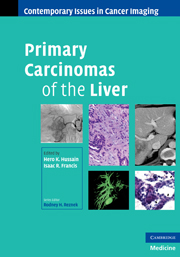Book contents
- Frontmatter
- Contents
- Contributors
- Series foreword
- Preface to Primary Carcinomas of the Liver
- 1 Epidemiology of hepatocellular carcinoma and cholangiocarcinoma
- 2 Surveillance and screening for hepatocellular carcinoma
- 3 Pathology of hepatocellular carcinoma, cholangiocarcinoma, and combined hepatocellular-cholangiocarcinoma
- 4 Radiological diagnosis of hepatocellular carcinoma
- 5 Staging of hepatocellular carcinoma
- 6 Surgical treatment of hepatocellular carcinoma: resection and transplantation
- 7 Non-surgical treatment of hepatocellular carcinoma
- 8 Radiological identification of residual and recurrent hepatocellular carcinoma
- 9 Radiological diagnosis of cholangiocarcinoma
- 10 Staging of cholangiocarcinoma
- 11 Treatment of cholangiocarcinoma
- 12 Uncommon hepatic tumors
- Index
- Color plates
- References
1 - Epidemiology of hepatocellular carcinoma and cholangiocarcinoma
Published online by Cambridge University Press: 04 August 2010
- Frontmatter
- Contents
- Contributors
- Series foreword
- Preface to Primary Carcinomas of the Liver
- 1 Epidemiology of hepatocellular carcinoma and cholangiocarcinoma
- 2 Surveillance and screening for hepatocellular carcinoma
- 3 Pathology of hepatocellular carcinoma, cholangiocarcinoma, and combined hepatocellular-cholangiocarcinoma
- 4 Radiological diagnosis of hepatocellular carcinoma
- 5 Staging of hepatocellular carcinoma
- 6 Surgical treatment of hepatocellular carcinoma: resection and transplantation
- 7 Non-surgical treatment of hepatocellular carcinoma
- 8 Radiological identification of residual and recurrent hepatocellular carcinoma
- 9 Radiological diagnosis of cholangiocarcinoma
- 10 Staging of cholangiocarcinoma
- 11 Treatment of cholangiocarcinoma
- 12 Uncommon hepatic tumors
- Index
- Color plates
- References
Summary
Hepatocellular carcinoma (HCC) is the fifth most common cancer and the third cause of cancer-related deaths worldwide. Cholangiocarcinoma (CCA) is the second most common primary liver tumor and is less common than HCC. The latest data from the Surveillance, Epidemiology and End Results (SEER) program, a population-based study on cancer incidence, prevalence, and mortality in the United States, show that primary liver cancer (90% HCC and 10% CCA) is one of few tumors with a rising incidence over the last 10 years (Figure 1.1). We herein discuss the epidemiology and risk factors for these tumors.
Hepatocellular carcinoma
The largest concentration of HCC cases in the world is in Asia, followed by Africa, Europe, and North and South America. The incidence of HCC varies among ethnic groups, with increasing incidence rates found in Japanese (5.5/100 000 in men and 4.3/100 000 in women), African American (7.1/100 000 in men and 2.1/100 000 in women), Hispanic (9.8/100 000 in men and 3.5/100 000 in women), and Chinese (16.2/100 000 in men and 5/100 000 in women) populations. Even though the incidence rate is greater in men compared to women, there is a 2- to 5-fold higher incidence rate among women of various ethnicities compared to non-Hispanic white women. During the last two decades, an increasing trend in the incidence of HCC has been noted in Australia, Central Europe, the United Kingdom, Japan, and North America.
- Type
- Chapter
- Information
- Primary Carcinomas of the Liver , pp. 1 - 9Publisher: Cambridge University PressPrint publication year: 2009



